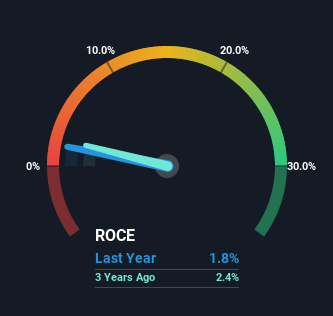
If you're not sure where to start when looking for the next multi-bagger, there are a few key trends you should keep an eye out for. Firstly, we'll want to see a proven return on capital employed (ROCE) that is increasing, and secondly, an expanding base of capital employed. Ultimately, this demonstrates that it's a business that is reinvesting profits at increasing rates of return. However, after investigating Byke Hospitality (NSE:BYKE), we don't think it's current trends fit the mold of a multi-bagger.
Return On Capital Employed (ROCE): What Is It?
For those who don't know, ROCE is a measure of a company's yearly pre-tax profit (its return), relative to the capital employed in the business. To calculate this metric for Byke Hospitality, this is the formula:
Return on Capital Employed = Earnings Before Interest and Tax (EBIT) ÷ (Total Assets - Current Liabilities)
0.018 = ₹41m ÷ (₹2.6b - ₹353m) (Based on the trailing twelve months to June 2022).
Therefore, Byke Hospitality has an ROCE of 1.8%. Ultimately, that's a low return and it under-performs the Hospitality industry average of 7.6%.
See our latest analysis for Byke Hospitality

Historical performance is a great place to start when researching a stock so above you can see the gauge for Byke Hospitality's ROCE against it's prior returns. If you're interested in investigating Byke Hospitality's past further, check out this free graph of past earnings, revenue and cash flow.
So How Is Byke Hospitality's ROCE Trending?
On the surface, the trend of ROCE at Byke Hospitality doesn't inspire confidence. Around five years ago the returns on capital were 31%, but since then they've fallen to 1.8%. Although, given both revenue and the amount of assets employed in the business have increased, it could suggest the company is investing in growth, and the extra capital has led to a short-term reduction in ROCE. And if the increased capital generates additional returns, the business, and thus shareholders, will benefit in the long run.
In Conclusion...
Even though returns on capital have fallen in the short term, we find it promising that revenue and capital employed have both increased for Byke Hospitality. Despite these promising trends, the stock has collapsed 74% over the last five years, so there could be other factors hurting the company's prospects. Regardless, reinvestment can pay off in the long run, so we think astute investors may want to look further into this stock.
One final note, you should learn about the 3 warning signs we've spotted with Byke Hospitality (including 2 which are a bit concerning) .
If you want to search for solid companies with great earnings, check out this free list of companies with good balance sheets and impressive returns on equity.
Valuation is complex, but we're here to simplify it.
Discover if Byke Hospitality might be undervalued or overvalued with our detailed analysis, featuring fair value estimates, potential risks, dividends, insider trades, and its financial condition.
Access Free AnalysisHave feedback on this article? Concerned about the content? Get in touch with us directly. Alternatively, email editorial-team (at) simplywallst.com.
This article by Simply Wall St is general in nature. We provide commentary based on historical data and analyst forecasts only using an unbiased methodology and our articles are not intended to be financial advice. It does not constitute a recommendation to buy or sell any stock, and does not take account of your objectives, or your financial situation. We aim to bring you long-term focused analysis driven by fundamental data. Note that our analysis may not factor in the latest price-sensitive company announcements or qualitative material. Simply Wall St has no position in any stocks mentioned.
About NSEI:BYKE
Proven track record with adequate balance sheet.
Similar Companies
Market Insights
Community Narratives



